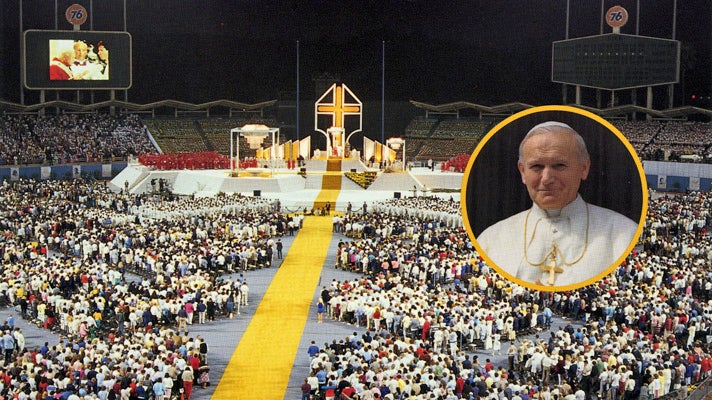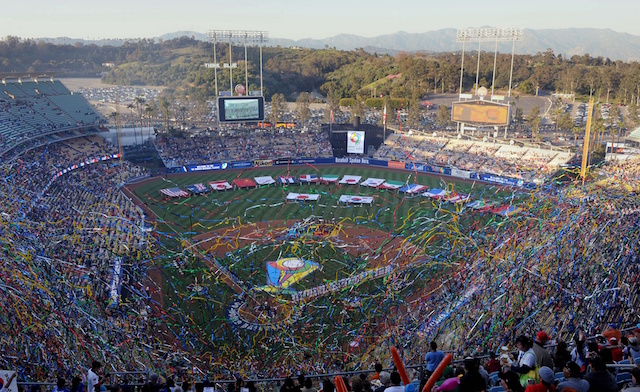Dodger Stadium
 https://www.ballparksofbaseball.com/ballparks/dodger-stadium/a caption
https://www.ballparksofbaseball.com/ballparks/dodger-stadium/a caption
About Dodger Stadium:
Dodger Stadium is a baseball stadium in the Elysian Park neighborhood of Los Angeles, California. It is the home stadium of Major League Baseball's Los Angeles Dodgers. Opened in 1962, it was constructed in less than three years at a cost of US$23 million. Dodger Stadium's address is 1000 Vin Scully Ave, Los Angeles, CA 90012. Dodger Stadium can hold over 50,000 fans, and it frequently sells out. Since opening it's gates, Dodger Stadium has hosted 10 World Series, providing a great atmosphere for fans during the Fall Classic. Dodger Stadium is the ultimate place to enjoy a ball game and enjoy some rich history.
History of development of Dodger Stadium (Chávez Ravine):
The construction of Dodger Stadium in September of 1959 came with major controversy. It was built in a valley just north of Downtown Los Angeles called Chávez Ravine. Before the construction of Dodger Stadium in Chávez Ravine, the area was considered a Mexican-American dominant tight-knit community (Mechner). The Chávez Ravine was comprised of multiple neighborhoods which included Palo Verde, Bishop, And La Loma. the population of these three neighborhoods was estimated to be 1,100 households (The Real Story). The view of Chávez Ravine within the community was a self-sustaining small town that offered all the essentials to residents. But views outside the community saw the neighborhoods of Chávez Ravine as lower-income housing that does not meet the views of the city being looked at by officials as vacant shanty towns (Mechner). These outside views of Chávez Ravine were looked at as prime redevelopment locations which led to city grants to improve the neighborhoods of Chávez Ravine in 1949 (Mechner). Residents were told and issued eviction notices stating, the land would be converted to 10,000 unit housing projects that contained new schools, roads, parks, and playgrounds (Mechner). The residents would also have to sell their houses but would be entitled to the first choice in the new housing projects (Mechner). Many residents did not adhere to the notice and continued to stay in their homes while many left their homes. The city of Los Angeles viewed the residents who stayed in their homes despite orders as squatters and were forced by government officials to move and received very little to no compensation at all (Mechner). Chávez Ravine was now owned by the city of Los Angeles stripping the land from the original owners. The once generational Mexican-American neighborhoods were now demolished and leveled turning the tight-knit empty and vacant. Although leveled and demolished Chávez Ravine was never constructed into the public housing projects that were promised by the city. This was the result of the 1950s constant shifting in public opinion. The original agreed intentions for the redevelopment of Chávez Ravine were to give improved services to lower-income neighborhoods. This was denied with the shifting social and political view of federal public housing. The federal public housing plans for Chávez Ravine were now viewed as a communist and socialist movement having many that once agreed now opposed to these developments (Mechner). Corporate industries wanting to use this land for private intention launched anti-communist propaganda against the use of Chávez Ravine as public housing helping to sway public opinion of Chávez Ravine’s federal housing plan(Mechner). Having the political views shift politically of the development in the city of Los Angeles caused them to try canceling this process. The cancellation process was held at the federal level court and found that the city of Los Angeles would not be able to cancel the process due to the public housing contract being legally binding (Mechner). The new mayor of Los Angeles committed to stopping Chávez Ravines managed to negotiate with the federal government and was able to buy the land back at the exception it is public use (Mechner). During this time in Major League Baseball, the New York Giants were unable to build a stadium in New York looked towards the booming West-coat cities landing in San Fransisco (Dodger Stadium). Seeing the interest in the west coast cities the Brooklyn Dodgers decided to also move (Dodger Stadium). Although Los Angeles gaining immense popularity as a city in the 1950s it still did not have a Major league sports team (Mechner). To the Brooklyn Dodgers owner Walter O’Malley and the city of Los Angeles, this would be a great location to construct a stadium being a desirable city. The Dodgers would move with the Giants relocating to the desirable west coast following the 1957 season (Dodger Stadium). Walter O’Malley was able to acquire the land of Chávez Ravine and the minor league team the Los Angeles Angels for a fraction of the price the city of Los Angeles obtained Chávez Ravine from the federal government (Mechner). This agreement for the new stadium sparked major public outcry resulting in lawsuits halting the processes. Supporters against the stadium argued the city acted in illegal deals that denying public interests. While supporters of the stadium argued the people opposed did not enjoy baseball (Mechner). To continue the process of building the stadium at Chávez Ravine a public vote was held. The stadium construction won by the public vote of 3% with the stipulation that O’Malley would have to return the Angels Minor league team and stadium back to the city of Los Angeles (Mechner). Having lawsuits concluded, O’Malley was now able to construct Dodger Stadium on the 352 acres of Chávez Ravine land (Dodger Stadium). The construction of Dodger Stadium started on September 17, 1959 building over the once generational neighborhoods of Chávez Ravine (Dodger Stadium). The Dodgers would play at the Coliseum until the construction of Dodger Stadium was complete. Dodger Stadium construction was completed by the 1962 season playing the first game in their new stadium on April 10 against the Cincinnati Reds and was also used for three seasons by the Los Angeles Angels (Dodger Stadium). The completion of Dodger Stadium made it the third-oldest stadium only having Fenway Park and Wrigley Field built before. Dodger stadium allows a capacity of 52,000 with 5 level sections and multiple massive parking lots around the stadium (Dodger Stadium). Dodger Stadium has not changed much over the years only renovating the stadium for improvements and has become an iconic stadium with Major League Baseball. Chávez Ravine’s neighborhoods of La Loma, Bishop, and Palo Verde were now buried by Dodger Stadium having generations of Mexican-American facing tragedy losing their properties and communities forced out of their homes with little compensation for the promise that was not met because of the actions caused by the city of Los Angeles.
Chávez Ravine Photos: Herald-Examiner Collection 1959/Los Angeles Public Library, Leonard Nadel/ Getty Research Institute and Gary Regester:
Special Events at Dodger Stadium:
Although Dodger Stadium is home of a Major League Baseball team, they have hosted many special events in the past. Some of these events include a ski jumping exhibition in 1963, the Harlem Globetrotters in 1964, Elvis Presley and The Beatles in 1966, and many other artists like Elton John and Micheal Jackson. Pope John Paul II also held a speech at Dodger Stadium, with over 60,000 people in attendance. Dodger Stadium has always been a great atmosphere to experience all different types of events, not just baseball.

Photo courtesy of Los Angeles Dodgers
2017 World Baseball Classic championship at Dodger Stadium:
The Dodgers hosted the 2017 World Baseball Classic championship at Dodger Stadium from March 20 to 22, 2017. The World Baseball Classic (WBC) is an international baseball tournament sanctioned from 2006 to 2013 by the International Baseball Federation (IBAF) and after 2013 by World Baseball Softball Confederation (WBSC) in partnership with Major League Baseball (MLB). Dodger Stadium hosted the Championship round, and it was a single elimination tournament. Team USA won the championship that year. This was a great event to be held at Dodger Stadium as it attracted all different people from all over the world to enjoy a game in Los Angeles.

https://dodgerblue.com/2017-world-baseball-classic-championship-round-dodger-stadium-final-four-japan-netherlands-puerto-rico-usa/2017/03/20/
Stadium Performances:
This stadium has had many historical sports moments in this stadium. There has been a perfect game pitched there and multiple no hitters. This stadium has hosted an all star game and many world series games including the game where Kurt Gibson hit a walk off homer in game one of the world series. This stadium is located in the heart of Los angles and has one of the largest fan bases in Major League Baseball. Dodger stadium has also had a major league hockey game played there. The Los Angles Kings played against the Anaheim Ducks in one of the first ever outdoor hockey games. This stadium most famous food is the Dodger dog. A dodger dog is a hot dog that many of the fans enjoy while watching the baseball game. The city of Los Angles loves this team and have had loyal fans for a long time. Dodger stadium has had an issue in previous years with the parking at the stadium. They have recently updated the parking lot and have received a lot of positive feedback as a result. There are 10 peoples numbers who are retired at Dodger Stadium. This means that no one else will wear those numbers in a Dodger uniform ever again. People get their numbers retired if they do a lot for the franchise and have helped it become what it is today. The people who play for the Dodgers and run the organization is always going to change. The one thing that has remained consistent for over 50 years is the stadium where they have played. The players who play there love it, and the fans do as well. Dodger stadium has a great reputation for the amount of attendance they receive for majority of their games. Many tourist in Los Angles go to Dodger baseball games to enjoy the nice weather, the good food, and to watch the Dodgers play baseball.
Sources:
http://www.pbs.org/independentlens/chavezravine/cr.html
https://www.kcet.org/shows/lost-la/they-moved-mountains-to-build-dodger-stadium
http://www.walteromalley.com/stad_hist_page1.php
http://la.curbed.com/2016/4/3/11358092/dodger-stadium-history-chavez-ravine
http://www.truebluela.com/2015/4/7/8363333/dodger-stadium-rainout-history
“Dodger Stadium”, Los Angeles Dodgers Ballpark - Ballparks of Baseball.” Ballparks of Baseball - Your Guide to Major League Baseball Stadiums, https://www.ballparksofbaseball.com/ballparks/dodger-stadium/.
Mechner, Jordan. “Chávez Ravine: A Los Angeles Story.” Zinn Education Project, 25 Apr. 2020, https://www.zinnedproject.org/materials/chavez-ravine.
“The Real Story.” - LA LOMA - BISHOP - PALO VERDE - The Real Story of Chavez Ravine, https://www.notchavezravine.org/the-real-story.html.
https://www.mlb.com/dodgers/ballpark
https://www.discoverlosangeles.com/the-greatest-non-baseball-events-in-dodger-stadium-history
https://en.wikipedia.org/wiki/2017_World_Baseball_Classic_championship
https://dodgerblue.com/2017-world-baseball-classic-championship-round-dodger-stadium-final-four-japan-netherlands-puerto-rico-usa/2017/03/20/


